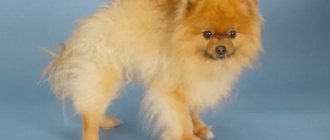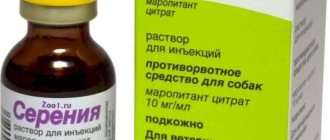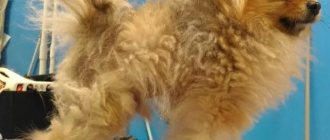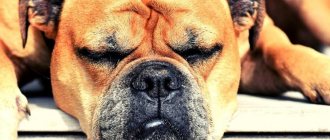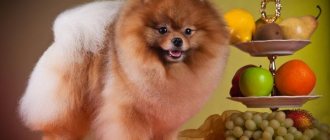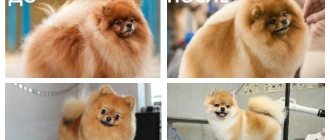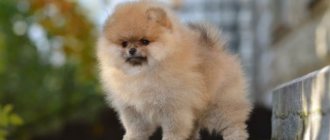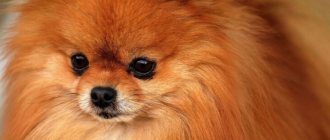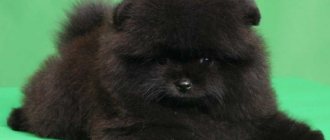A breed such as the Spitz is characterized by thick, long hair. It is the beautiful fur coat that frames the pet’s body that is the main feature of this breed. For any dog of nature, shedding, during which the hair quickly falls out. This is a temporary process that gradually stops after its peak. If the hair continues to thin out over a long period with high intensity, you should immediately contact a veterinarian. Alopecia in a Spitz is a set of symptoms that cause the hair to quickly fall out, which can lead to complete baldness of the pet.
The main causes of Spitz alopecia
Alopecia is a little-studied phenomenon that occurs predominantly in males. The exact causes of symptoms that worsen the pet’s appearance have not yet been established. The Spitz becomes bald and his skin darkens, but this does not prevent the dog from maintaining its usual lifestyle. There is no pain, no itching. Symptoms can manifest in two types:
- The pet sheds as expected and ends on time. When the dog is 2–3 years old, symmetrical bald patches may appear on the hind legs and sides. Gradually, bald spots spread across the body. Over time, the fur will remain only on the front paws and head.
- Puppies do not lose their hair during shedding. It quickly thickens and becomes like cotton wool. When the puppy turns 15 months old, the fur begins to actively fall out. At the same time, the exposed skin acquires a dark shade.
However, there are many situations where a pet lived without problems for 8–10 years and only then its hair began to actively fall out, regardless of shedding. After a long study of this disease, researchers have identified several possible causes that can lead to the appearance of unpleasant symptoms.
Poor care
Black skin disease in Spitz dogs with severe hair loss can occur due to improper care of pets. If you don't take care of the fur at all, problems cannot be avoided. You can reduce the risk of alopecia by brushing your Spitz daily with a massage brush. It is recommended to perform the procedure 3 times a day for several minutes. Active growth of hair follicles begins after regular massage of thick fur.
Note! Veterinarians recommend using a special spray that is applied to the hair before combing. Spitz dogs need to be washed at least once a month.
Poor nutrition
In the course of research, scientists have proven that 60% of the nutrients that a Spitz receives from food are spent on maintaining and forming hair. Because of this, you need to take a smart approach to preparing your pet’s diet.
It is strictly forbidden to give the dog any food from the table. These can be various bones, sausages, sweets, chips, and so on. They are not only harmful, but also wean your pet off proper nutrition. He begins to constantly beg for food from his owners, stopping to eat the recommended food. The dog must be weaned from this habit first.
Expert opinion
Anna Abramenko
An avid dog lover. Experience in veterinary medicine since 2009.
Ask a Question
To feed your Spitz, you need to purchase special food that belongs to the super-premium class.
In addition to purchased mixtures, you can independently develop a diet based on natural products. We must not forget about fruits and vegetables, which are rich in vitamins and beneficial microelements. If the diet is incorrect, the coat will gradually become dull. After a short period of time, active hair loss will begin, not associated with shedding.
Walks
Regardless of the fact that the Spitz is a decorative breed of dog, it should be walked every day in any weather. Veterinarians advise going out with your pet 2 times a day into fresh air for at least 30 minutes.
Note! There is no need to wear protective overalls for walking your dog, regardless of the time of year. If the animal's fur is healthy, dirt does not stick to it much.
Prevention
Constantly following the recommendations of veterinarians and Spitz breeders helps owners avoid alopecia in their dogs.
- Quality food. It is necessary to feed your Spitz with premium, super-premium commercial ready-made food, or a fully balanced diet of fresh products prepared independently. When feeding natural food, it is necessary to take into account all the dog’s nutritional needs, do not forget about fermented milk products, fresh vegetables and fruits. A Spitz owner can get nutritional recommendations from their breeder or veterinarian.
- Inclusion in the diet of supplements, vitamin and mineral complexes aimed at strengthening the immune system and improving the quality of the coat. Olive oil, omega-3 polyunsaturated fatty acids, fish oil, vitamin E - improve coat and skin, accelerate the shedding process and activate new hair growth. Rose hips, berries, sea fish - restore and support immunity. Pet stores offer ready-made tablet or liquid vitamin complexes for dogs, among which each owner can choose the optimal one for his dog.
- Your Spitz should be washed weekly using moisturizing shampoos and conditioners. Be sure to dry your dog completely and thoroughly to avoid getting the coat wet - this can cause eczema and dermatitis.
- You need to brush your Spitz every day with a massage brush. It is important to comb the wool completely, from the very roots, without leaving tangles. This will accelerate the loss of dead hair and awaken the follicles for active growth of the fur coat. Experienced breeders recommend moistening the Spitz's coat with a moisturizing conditioner diluted with water in a ratio of 1:10 before combing. Particular attention should be paid to combing during the period of shedding - the maximum loss of dead hair. In males, shedding occurs twice a year, in spring and autumn, in females, plus the off-season - before, during or after estrus, pregnancy, the period of feeding puppies
- Timely deworming and vaccination. If the Spitz's body is weakened by parasites, the dog's immunity and overall body resistance are reduced, which means the risk of baldness increases and treatment in this situation will be longer and more complex. Timely vaccination allows you to protect your animal from common infections that are dangerous in themselves and reduce the body’s defenses.
Read Nausea and vomiting in dogs: causes, signs and treatment
Diagnostics
If the owner notices that the pet is actively losing hair, regardless of shedding, this process does not stop, you should immediately contact a veterinarian. To confirm the presence of alopecia, the doctor must make sure that the thinning coat is not due to the effects of other diseases. These include:
- Cushing's syndrome;
- hypothyroidism;
- inflammation of the sebaceous glands;
- hyperestrogenism.
A common reason in veterinary practice that causes Pomeranians to actively go bald is Cushing's syndrome. It manifests itself with a number of symptoms:
- Hair falls out most intensively from the neck, body, and tail.
- The pet is thirsty and often asks to go to the toilet.
- Muscles weaken.
- The Spitz begins to actively lose weight.
- The stomach sags.
Another common cause of dog hair loss is hypothyroidism. It occurs due to a lack of thyroid hormones. This disease manifests itself with the following symptoms:
- He is actively gaining weight.
- The animal is lethargic and gets tired quickly.
- The upper layers of the skin become cold.
- Visible damage to the skin appears on the sides and back.
To distinguish alopecia from other diseases, the veterinarian prescribes a number of diagnostic procedures. These include:
- Skin biopsy.
- Urine and blood analysis.
- Thyroid examination.
- Determination of hormonal levels.
What does a typical alopecia patient look like?
It is worth noting that not only Spitz dogs are susceptible to this pathology, but also chow chows, poodles and other small dogs. As a rule, the first signs of baldness begin to appear not at an early age, but at a more mature age, when the dog turns 3 years old.
First of all, owners pay attention to the fact that the animal begins to lose long hair. As a result, he is left with very short fluff or undercoat. If you look at the photo, hairless Spitz dogs do not completely lose their hair. Basically, the pathology begins with bald patches.
At the same time, there are no ulcers, inflammations or other unpleasant phenomena on the bald areas of the skin. As a rule, the skin remains smooth and does not even itch. It seems that the animals are not worried at all. However, when looking at pictures of hairless Spitz dogs, a feeling of hostility involuntarily arises. This is more of an aesthetic problem. Therefore, I want to correct this situation as quickly as possible. To accurately determine the reason why your Spitz is bald, you should pay attention to the pet’s symptoms and behavior.
Treatment
Due to the fact that the exact causes of alopecia in dogs are unknown, it is difficult to completely cure your pet. If a diagnosis is made, comprehensive treatment is prescribed. It consists of a number of procedures:
- Castration.
- The use of mesoscooters.
- Taking Trilostane, Melatonin.
- Regular examinations with a doctor.
Expert opinion
Anna Abramenko
An avid dog lover. Experience in veterinary medicine since 2009.
Ask a Question
Hormone therapy will help quickly cope with unpleasant symptoms. However, when taking medications, it is important to strictly follow the dosage.
Castration
Unneutered pets need to have their testicles removed as soon as possible after detection of alopecia. Doctors have proven that in 50% of cases after this procedure, the dog’s general condition improves. To increase the effectiveness of castration, you need to use a chemical method. Its main disadvantage is that the price is 3 times higher than the usual procedure.
Hormone therapy
If there is no improvement after castration or the pet was sterilized before hair loss began, hormonal therapy is prescribed. It is based on taking melatonin. The duration of the treatment course is up to 3 months. The dog should eat 3 tablets per day.
Expert opinion
Anna Abramenko
An avid dog lover. Experience in veterinary medicine since 2009.
Ask a Question
During the course, the animal is under the supervision of a doctor. If the condition improves, the dosage is reduced to 2 tablets per day. Gradually it should be reduced to 1 per day.
Note! Melatonin should not be given to pets who suffer from diabetes. In this case, other drugs may be prescribed:
- Trilostane is an effective treatment, but the medicine has many side effects.
- Medroxyprogesterone is another effective treatment for alopecia. Gives a positive result in 50% of cases. It is injected into the body subcutaneously. The total number of injections is 4.
Dosages of drugs are prescribed by the attending physician, who must monitor the pet’s condition.
Mesodermorollers
To stimulate the growth of new hair, veterinarians use a method of gently traumatizing the affected areas of the skin. This procedure is performed using a multi-needle dermoroller. It is a medical instrument consisting of a drum with needles. After the procedure, many small holes are left on the pet's skin. Thanks to this, regeneration processes are activated.
Causes of baldness
Although the causes of the disease are not fully understood, the most likely are:
- Pomeranians are susceptible to thyroid diseases. Alopecia X occurs when growth hormones, estrogen or cortisol are disrupted;
- elderly age;
- period of molting or coat change;
- stress;
- after clipper haircut;
- improper feeding;
- allergic reaction;
- the presence of a fungal, viral or bacterial disease;
- insufficient care of the animal, including its fur.
One common cause is the presence of parasites (fleas and ticks) in the puppy. In this case, it is necessary to carry out procedures to get rid of them. If after molting the animal continues to lose hair, this is a reason to worry.
Alopecia after haircut
There are situations when alopecia occurs after cutting a Spitz with a clipper. Researchers explain this by saying that in this case the hair is cut off right to the root. Because of this, a lot of “stumps” remain, which the pet cannot get rid of for a long time.
Spitz often begin to go bald regardless of the molting process or continue after it. This phenomenon can lead to complete baldness of the pet, darkening of bare skin areas. The exact causes of these symptoms are unknown, making treatment difficult. If your dog begins to actively go bald after shedding or at unusual times, you should immediately contact a veterinarian.
What is alopecia like in a Spitz?
Alopecia is a disease in Spitz dogs in which there is significant loss of hair in the abdominal area, tail and hind legs. This disease most often affects Spitz dogs, which have this thick coat.
In addition, where the hair has fallen out, the skin may become darker, and comedones and peeling may appear. It must be emphasized that with alopecia, it is the dog’s external appearance that suffers to a greater extent, and the animal itself does not experience great inconvenience from baldness (it does not itch or lick itself).
But exposing areas of the pet’s skin can incite other various diseases in the dog that are already difficult to heal, for example, skin fungus. So owners should immediately begin healing when the first signs of alopecia are detected.
Prevention of baldness in Pomeranians
If you notice that the dog is becoming very bald, then, first of all, change the diet and review the degree of care for the Spitz's coat . Most often, the reason lies in this. For a month, wash your dog once every 3 days with Nizoral shampoo if you notice fungal diseases due to baldness.
Deworm your pet, and to prevent the drug from causing itching, take antihistamines - all this is done in consultation with your veterinarian. The dog is given additional vitamins and its coat is brushed daily.
It is important to remember that any connivance in this situation is unacceptable. If you notice baldness on your Spitz's body, hips, or tail, immediately take him to the veterinarian and begin a comprehensive examination. Alopecia is treatable, the main thing is to properly care for the dog.
Why does alopecia appear?
Sometimes a hormonal imbalance occurs in the animal's body. In this case, the Spitz's baldness will be temporary. However, it will be difficult to distinguish it from standard alopecia yourself, so you will have to consult a specialist. And it’s better not to delay with this.
Unfortunately, doctors cannot yet clearly identify certain circumstances that lead to baldness in this breed of dog. However, there are several theories that make it easier to understand why this happens.
First of all, veterinarians are inclined to think that the genetic predisposition of a particular type of dog is to blame. If a malfunction occurs in the animal’s body, then in this case the cells of the hair follicles change their structure and, accordingly, begin to function differently than required.
The second theory suggests that the causes of baldness in Spitz dogs lie in poor heredity. If the puppy’s parents had similar defects and their hair growth cycle is disrupted, then in this case there is a high probability that the puppy will also suffer from this pathology.
Almost all doctors believe that alopecia cannot be the only disease. As a rule, it is a consequence of one or another pathology. This makes diagnostics difficult. It is more difficult for a specialist to identify the exact causes of the disease, and accordingly, prescribe the correct treatment.
When is temporary baldness considered normal?
It is worth paying attention to the fact that as animals grow older, they may have some problems with their coat. For example, with poor nutrition or during changes in temperature conditions. If we are talking about vitamin deficiency and other common conditions, then identifying this pathology is much easier. To do this, you need to pay attention to the fact that the dog’s coat has become too thin and has lost its shine and elasticity.
After baldness begins on the back, bald spots gradually appear on the sides, on the hips, tail and neck. The skin becomes completely exposed, begins to darken, its pigmentation increases, and in some situations the animals become simply black. The skin becomes covered with small spots, which gradually grow and occupy an increasingly larger area. In this case, we are not talking about molting, but about more serious health problems.
A number of studies are carried out (scraping, trichogram, clinical and biochemical blood tests, tests to determine hormone levels, abdominal ultrasound, sometimes skin biopsy, etc.).
If the specialist managed to determine through diagnostic measures what exactly caused the disease, treatment is prescribed.
